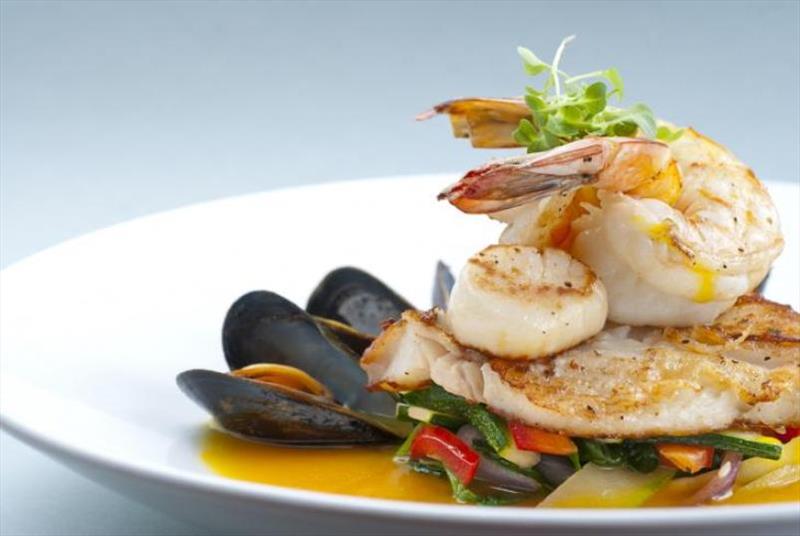
7 ways to celebrate national seafood month
by NOAA Fisheries 17 Oct 2021 15:46 UTC

Shrimp, scallops, mussels, and white fish © iStock
Temperatures are cooling, leaves are changing colors, and the smell of pumpkin spice fills the air—all signs of fall in the United States! This time of year is meaningful for many reasons.
At NOAA Fisheries, it's a time to celebrate seafood because October is National Seafood Month. Read on for ways you and your family can savor the flavors—and health benefits—of seafood.
1. Learn what makes U.S. seafood sustainable
In the United States, sustainable seafood is not only a possibility, it's our priority. Fish, shellfish, and marine algae are renewable resources—they can reproduce and replenish their populations naturally. That means we can sustainably harvest fish within certain limits without depleting their populations. Fishery management is the process of using science to determine these limits—catching some fish while leaving some to reproduce and replace the fish that are caught. The United States is a global leader in seafood sustainability. Learn more about what sustainable seafood means in the United States and how we are working to support healthy fisheries and provide safe sources of seafood.
2. Add more seafood to your diet
Fish and shellfish are a great source of lean protein. They're also rich in nutrients and omega-3 fatty acids that play a key role in heart, immune system, and brain health. The Dietary Guidelines for Americans recommend that everyone—from about 6 months and up—eat regular servings of seafood. If you're one of the almost 90 percent of Americans who doesn't meet this target, you could probably use some tips to add more seafood to your diet.
Think seafood is only a dinner-time treat? Think again! Follow these easy tips to up your seafood intake—this month and every month—and be sure to look for seafood harvested or farmed in the United States.
3. Try a new seafood from your region of the United States
In the United States, we love our seafood. Thankfully, due to strong science and a dynamic management process, our fisheries are among the largest and most sustainable in the world. So no matter what coast you're on, you can be sure that the U.S. seafood you find there is a smart choice. And just like the culture of each region has its own flavor, so does its seafood! Discover what local favorites you might find in your neck of the woods.
4. Try a new seafood from a different region of the United States
One of the best things about vacation is the chance to explore new foods. Fortunately, you don't need a travel itinerary to transport your taste buds to new locales. Expand your horizons by taking a gastronomic tour of the United States and supporting regional economies—all from the comfort of your kitchen.
When you're buying ingredients, be sure to check seafood product labels or ask where a product originated. All seafood sold in the United States is required to have a country of origin label on the package. And if it's U.S. seafood, it's sustainable seafood!
5. Add seafood to your tailgate!
As the weather cools and football season kicks into high gear, tailgate parties provide the quintessential outdoor venue to catch up with friends over food and drinks. They're also a great excuse to Eat Seafood, America! Incorporate fresh local seafood into classic party dishes or try out a new recipe inspired by a rival team's region. As you plan your next tailgate menu, keep U.S.-produced seafood in mind for healthy and sustainable protein. Check out these recipe ideas to score points at your next gathering!
6. Start planning your holiday season menus
Ready or not, the holidays are just around the corner, so it's prime time to start thinking about what you'll serve. If you're a seafood lover like we are, why not shake up your holiday menus with delicious, healthy, and sustainable fish and shellfish. Whether you try these recipes or stick to your own seafood holiday favorites, remember that seafood harvested in the United States is a sustainable choice.
7. Celebrate the simplicity
Life is complicated enough, but adding healthy and delicious sustainable seafood doesn't have to be difficult! Whether you're new to preparing fish and shellfish or an old salt in the seafood aisle, we've got you covered. And by choosing U.S.-produced seafood, you can be sure it's an environmentally sustainable option that supports U.S. fishermen and seafood farmers—and their families. Read on for some suggestions for simple seafood suppers.
Find more recipes for the U.S. seafood you love on FishWatch. Want to learn more about seafood but don't know where to start? FishWatch also arms you with the facts about what makes U.S. seafood sustainable—from the ocean or farm to your plate. Get up-to-date information on the status of harvested marine fish and farmed fish, and learn more about U.S. seafood.